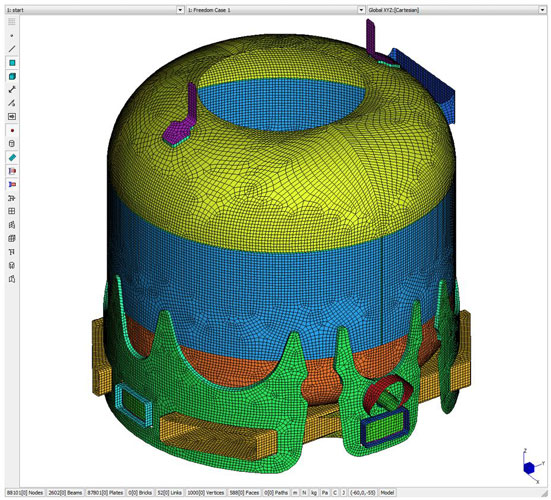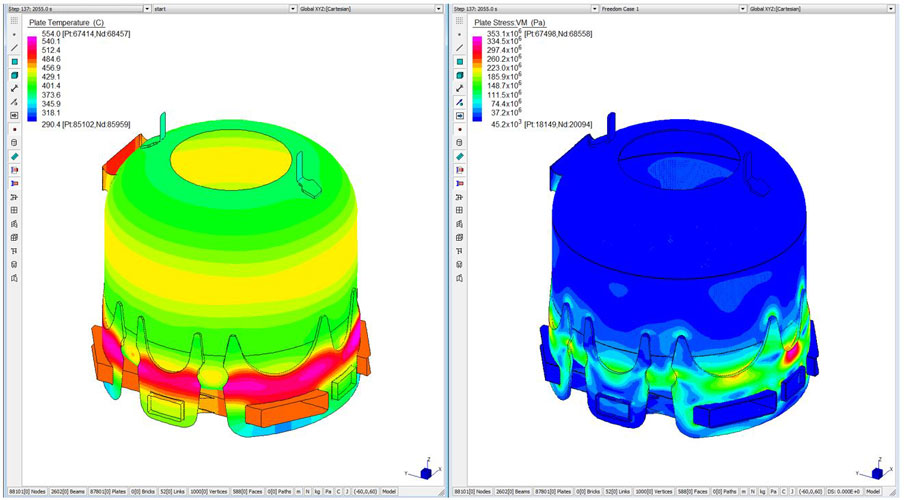The design review has been requested because of reiterated structural failures of the drum. As cracks appear on the outer surface of the ladle, an uncontrolled leakage of the molten zinc occur resulting in a dangerous condition for the operators. In order to guarantee the plant serviceability, our Customer arranged a warehouse with lots of spare drums for a fast maintenance in case of failure. Due to the large thermal gradient affecting the ladle during the melting process, the welding lines of the vessel were visibly cracked after only few hours of operations. The plant production was used to have several stops.
Furthermore, the welding repairs were not effective for the intended use of the ladle.
The systematic damages of the ladles, lead the customer to some assumptions about design deficiencies, to be confirmed and identified in order to finally solve the problem. The solid zinc recovery was a key target to enhance the plant efficiency and to save the dross wasting costs.
Category: Industrial plant
Date: 2019
Ladle weight: 620 kg
Zinc load bearing capacity: 1280 kg
Oven temperature: 600°C
Thermal cycle duration: 5.5 h


Objectives
The main objectives were the identification of the design faults, the investigation on possible solutions, the design updated and the final validation by means of thermal and mechanical analysis.
to be met
Among a variety of different reasons causing the ladle failure, the major issue to be investigated was a full-scale investigation of the structural behavior of the ladle undergoing thermal and mechanical loads, issued by using both Thermal and Non-Linear Solvers. Heated by a multi-flame burner, the outer skin of the barrel was reaching a temperature around 480°C. To spread out the thermal load all around the vessel of the ladle, a rotation at constant speed has been applied to the ladle by means of a driven mandrel, resulting in a uniform stirring of the molten zinc.
and results achieved
The analysis started by implementing a rough simulation able to investigate more in-depth the structural damaging. The process has been implemented including step-by-step the following stages:
- loading of the dross into the ladle;
- heating of the drum;
- rotating the drum;
- tapping the molten zinc;
- cooling the drum
The progress of the implemented analysis became helpful to better understand the most likely root of the problem. A significant thermal gradient of the molten zinc mass housed into the ladle has been shown, resulting in differential thermal expansions, probably ignored at the initial design stage of the ladle. Thus, the welding lines outside the drum were affected by very severe stress states, until the full collapse of the vessel. The FE models provided clear telltale indications about the topology of the most stressed areas and the Customer gave confirmation of the actual failure locations. At that time, having tested the reliability of the numerical model, we were able to suggest suitable solutions for the design review of the ladle. The geometry has been changed in order to achieve a new spreading of the thermal load. Particularly, the ladle has been redesigned by moving the welding lines far away from the locations with the highest thermal gradient. Furthermore, the heating process around the mantel of the ladle has been reviewed in order to make it as uniform as possible.
Taking advantage of the reiterated numerical simulations results, the optimized geometry has been identified leading to a proved structural integrity of the ladle undergoing the mechanical and the thermal loading. The new ladles can safely operate for a long-lasting period reaching at least 10 years, compared with only few hours of the previous design. Furthermore, the retrieving of the solid zinc dross, the increased serviceability of the ladles, the removal of the plant downtime costs and maintenance costs resulted in a outstanding improvement for the customer. As clearly stated by the customer, the engineering costs of the job have been immediately compensated by the efficiency enhancement of the plant.


